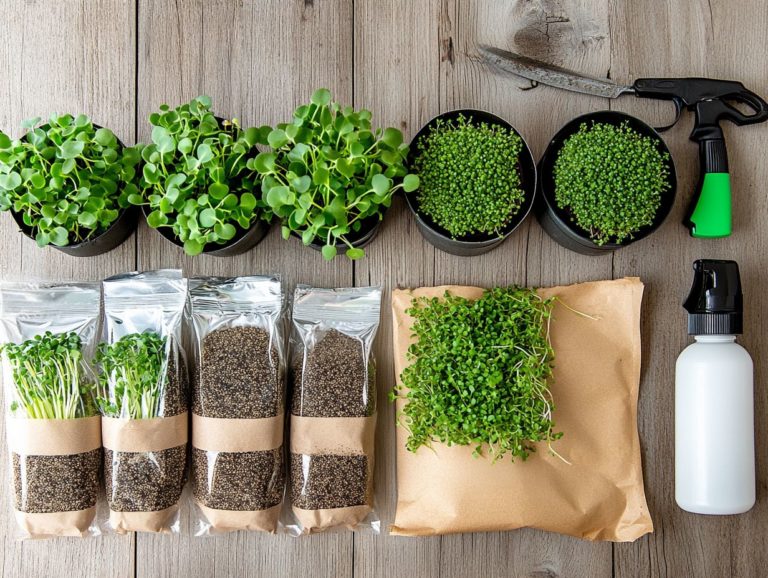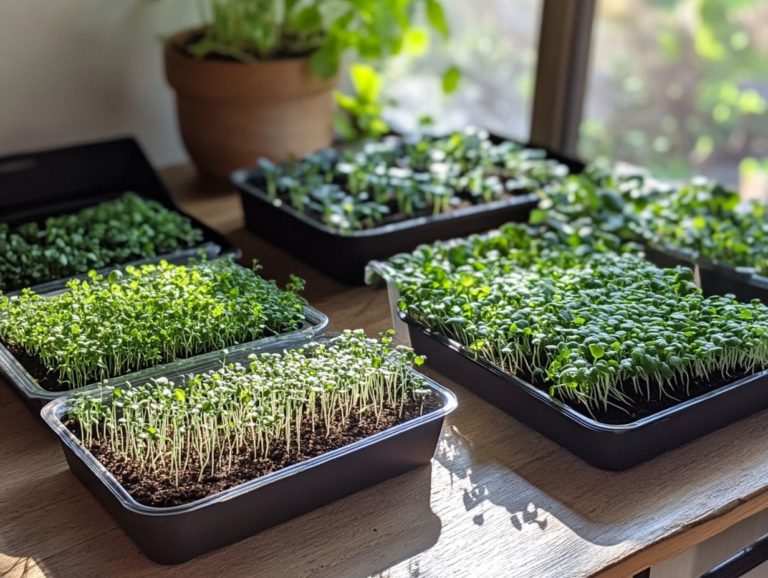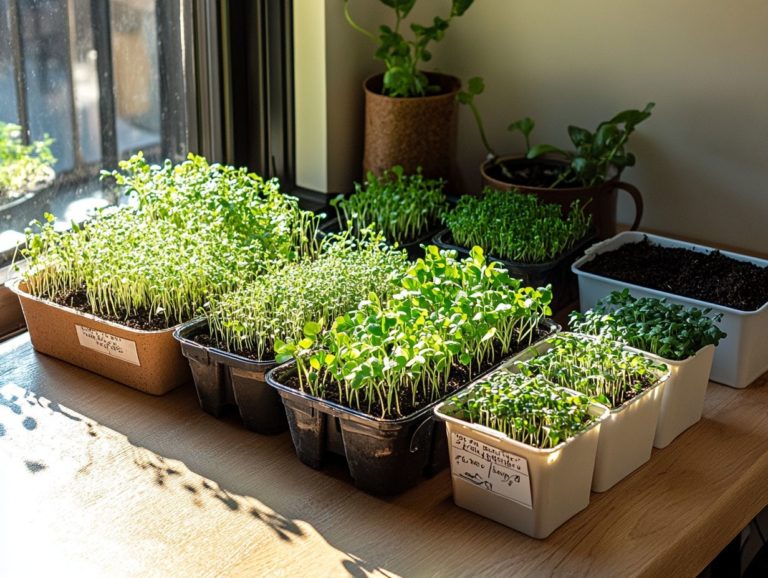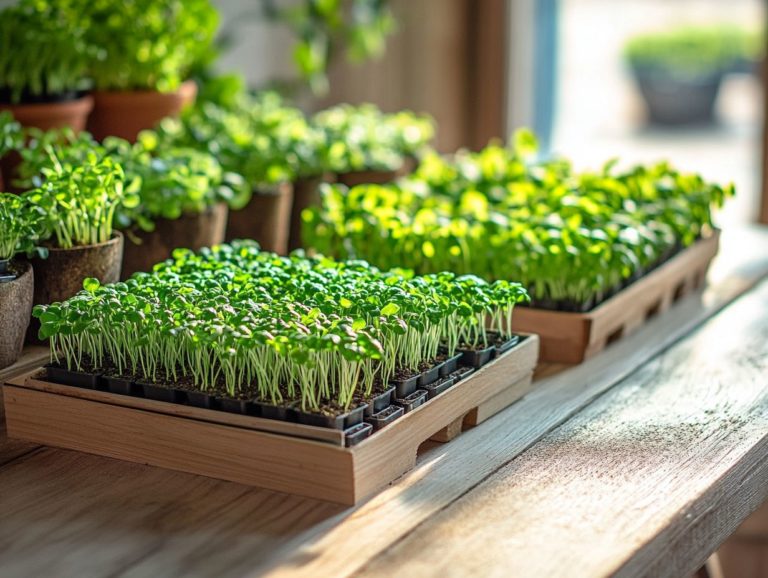Finding the Right Light Spectrum for Microgreens
Growing microgreens involves much more than merely providing water and soil; the light spectrum is a pivotal factor in their development.
By understanding how various light wavelengths influence growth, you can elevate your gardening experience, whether you’re relying on natural sunlight or utilizing artificial lighting solutions.
This article delves into the significance of the light spectrum for microgreens, comparing the merits of natural and artificial light options while offering valuable insights into the optimal lighting for each growth stage.
Get ready to unlock your microgreens’ full potential and watch them thrive like never before!
Contents
- Key Takeaways:
- The Importance of Light Spectrum for Microgreens
- Natural vs Artificial Light Sources
- Understanding the Different Light Spectrums
- Choosing the Right Light Spectrum for Your Microgreens
- Tips for Using Light Spectrum to Maximize Growth
- Frequently Asked Questions
- What is the importance of finding the right light spectrum for microgreens?
- What are the different light spectrums that can be used for growing microgreens?
- Which light spectrum is best for promoting leafy growth in microgreens?
- Does the light spectrum affect the flavor of microgreens?
- Can the light spectrum be adjusted during different stages of microgreen growth?
- What is the best way to determine the right light spectrum for my microgreens?
Key Takeaways:
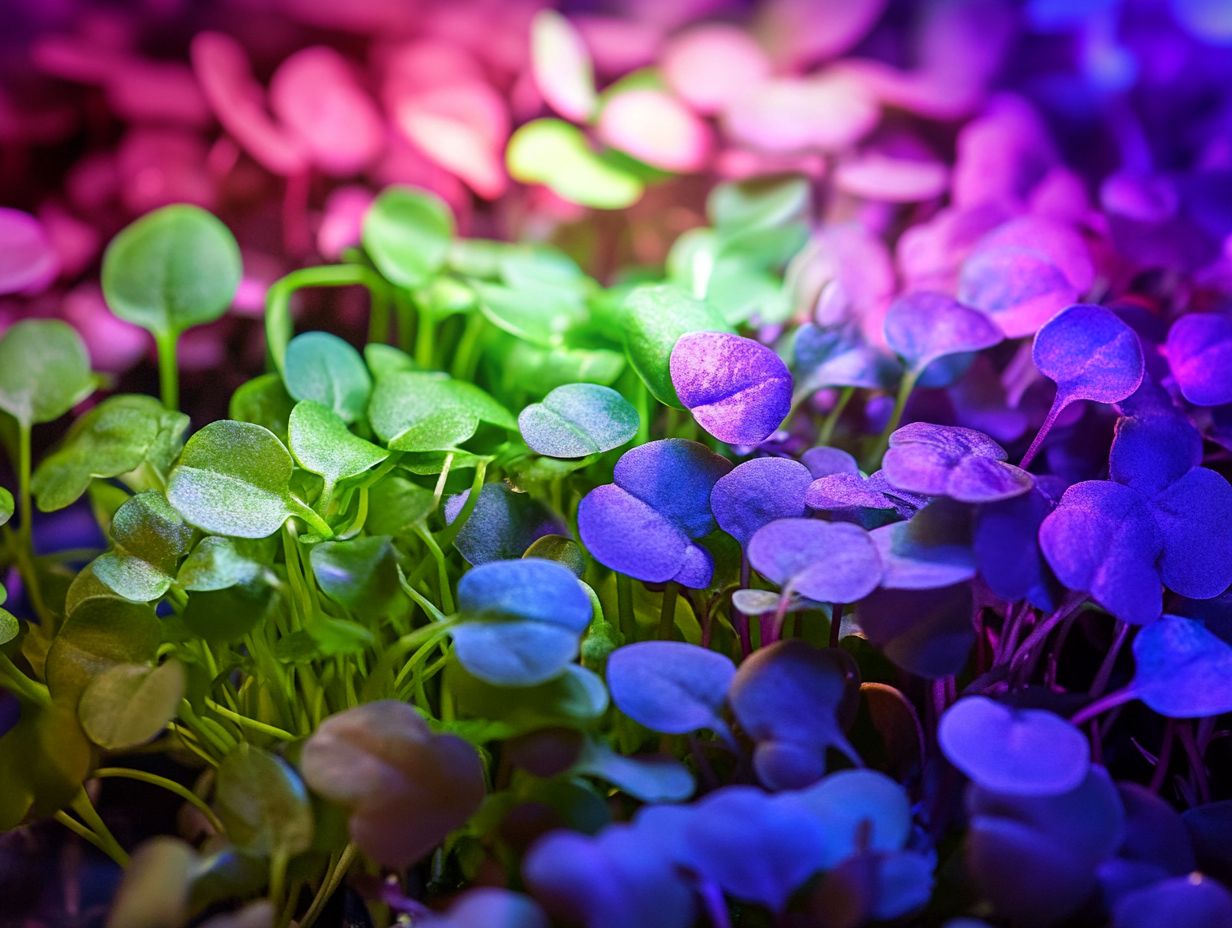
- The light spectrum plays a vital role in how your microgreens grow affecting their nutrients, flavor, and appearance.
- Both natural and artificial light sources have unique perks that can impact your microgreens’ growth.
- Understanding and properly utilizing blue, red, and white light spectrums can greatly benefit the growth of microgreens, leading to healthier and more vibrant plants.
The Importance of Light Spectrum for Microgreens
The light spectrum significantly influences the growth and development of microgreens. These tiny plants thrive on specific wavelengths of light to optimize photosynthesis and boost their nutrient content.
By harnessing various light sources, especially LED lights, you can greatly enhance their growth rate, quality, and flavor profile. Grasping the importance of different light spectrums, including full spectrum options, gives you the power to cultivate an ideal environment for your homegrown microgreens. To achieve optimal results, it’s also crucial to understand the perfect pH level for microgreens. Whether you’re nurturing them for personal enjoyment or aiming for commercial success, the right light is key.
Why Light Spectrum Matters for Growth
Understanding the significance of the light spectrum for microgreens is essential if you aim to optimize your cultivation methods and maximize your yield.
By examining how different light wavelengths impact photosynthetic efficiency, you can customize your lighting systems to enhance vital growth factors like germination rates and overall health. The relationship between Photosynthetic Photon Flux Density (PPFD), a measure of how much light is available for plants to use in photosynthesis, and ambient light conditions is key. Higher PPFD levels often lead to swifter microgreen development, assuming you also keep other growth factors, such as temperature and humidity, in check. Additionally, understanding how to select the right microgreen seeds can further optimize your growing success.
Different wavelengths play crucial roles in your plants’ physiological responses. For example, blue light promotes vegetative growth, while red light aids flowering. This highlights the importance of maintaining a balanced light spectrum, with top microgreen lighting solutions to ensure your crops not only survive but thrive.
Natural vs Artificial Light Sources
The choice between natural and artificial light sources is significant. This decision can profoundly affect both the quality and efficiency of your production, whether you re a dedicated home gardener or a commercial grower.
Pros and Cons of Each
Both natural and artificial light sources have unique perks that you should consider for optimal microgreen growth.
Natural sunlight provides essential wavelengths that promote vigorous photosynthesis and is often free, making it a cost-effective choice if you have ample outdoor space. However, factors like seasonal changes and inclement weather can limit its availability, posing challenges for consistent growth.
On the flip side, artificial lighting, especially LED systems, offers remarkable efficiency and precise control over light conditions. LEDs can significantly lower energy costs and reduce heat output, making them particularly suited for indoor setups. That said, they may require a higher initial investment, and their long-term environmental impact is still being debated compared to the benefits of sunlight.
Weighing these pros and cons is essential for anyone serious about cultivating microgreens effectively. Understanding light needs for microgreens can further enhance your growing techniques.
Understanding the Different Light Spectrums
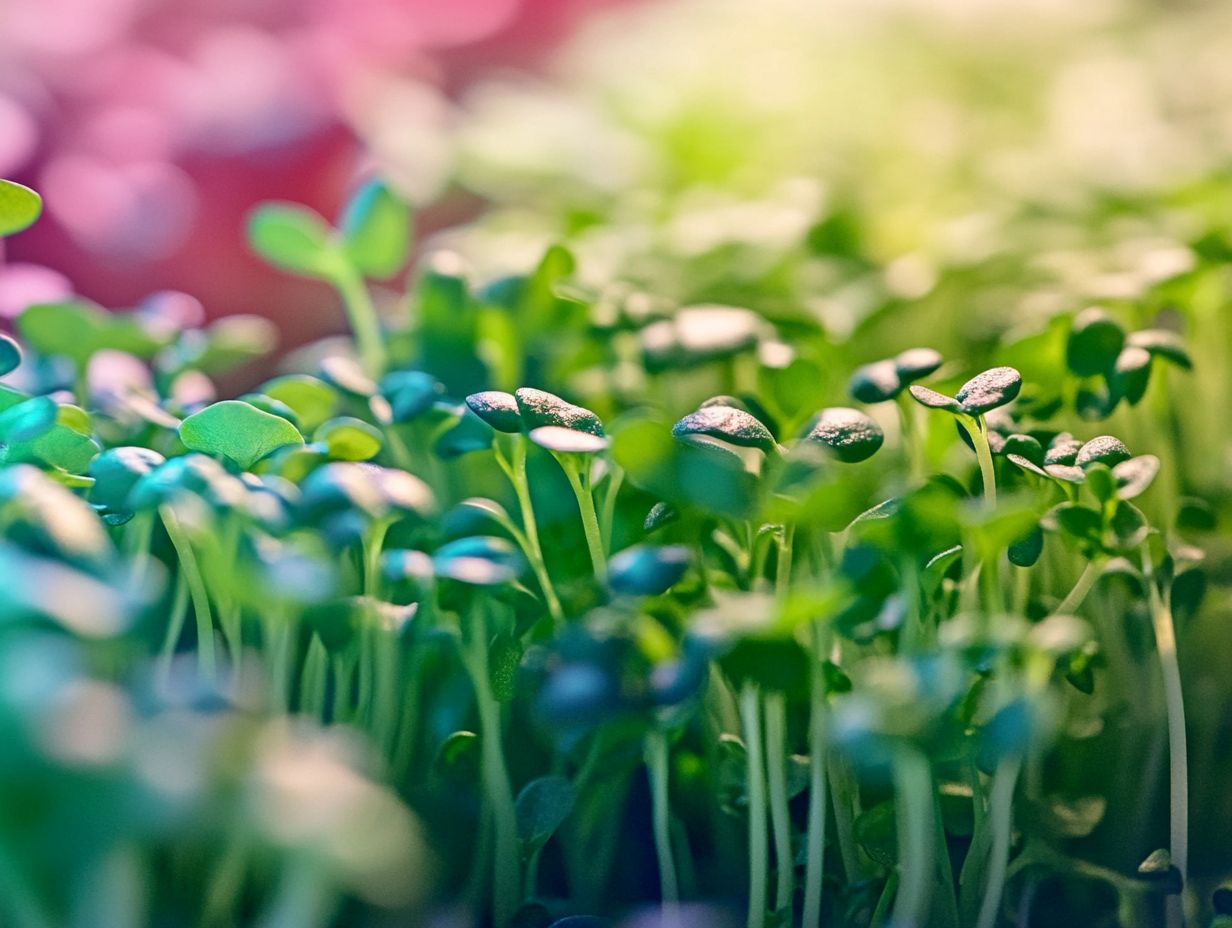
Understanding the various light spectrums available is crucial for you as a gardener aiming to optimize the growth of your microgreens. Different wavelengths can significantly impact photosynthesis and overall plant health. Therefore, it is essential to harness the right light for your gardening endeavors.
Blue Light Spectrum
The blue light spectrum is essential for the growth of microgreens. It significantly promotes their vegetative growth and enhances the photosynthetic process. This specific wavelength boosts chlorophyll production, which is crucial for absorbing light and plays a critical role in the overall health of these young plants.
Providing an optimal range of blue light in your growth environment stimulates quicker germination. It also fosters more robust development. To maximize these benefits, consider utilizing LED light configurations that emphasize the blue spectrum while incorporating some red light. For more detailed insights, explore the perfect light conditions for microgreens. This combination helps your microgreens get the right light for growing strong and healthy.
Red Light Spectrum
The red light spectrum is crucial in the flowering and fruiting stages of microgreens. It plays a significant role in developing robust, nutrient-rich plants. This specific wavelength promotes photosynthesis, boosts chlorophyll production, and stimulates the plant hormones vital for flowering.
You can optimize your indoor cultivation practices by using LED lights that emit a high concentration of red light. This tailored approach increases yield and enhances the flavor profile. Your microgreens will be visually appealing and nutrient-dense.
Harnessing this powerful light source can transform your growing environment. It enables you to produce crops that are both flavorful and healthy!
White Light Spectrum
The white light spectrum, commonly found in full-spectrum LED lights, offers a balanced range of wavelengths that supports every growth stage of your microgreens. By using this type of lighting, you can create an optimal environment that closely mimics natural sunlight essential for successful photosynthesis.
These LEDs excel in energy efficiency, reducing your electricity costs. They generate minimal heat, allowing you to place them closer to your delicate plants without fearing overheating.
Whether in your home garden or an urban farming setup, the advantages are numerous! They boost plant vigor and enhance yields, enabling you to grow year-round, come rain or shine.
This versatility makes full-spectrum LEDs a top choice for anyone passionate about cultivating a diverse array of greens.
Choosing the Right Light Spectrum for Your Microgreens
Selecting the appropriate light spectrum for your microgreens is paramount. It profoundly affects their growth, flavor, and overall vitality. Making informed choices is essential for achieving successful cultivation.
Factors to Consider
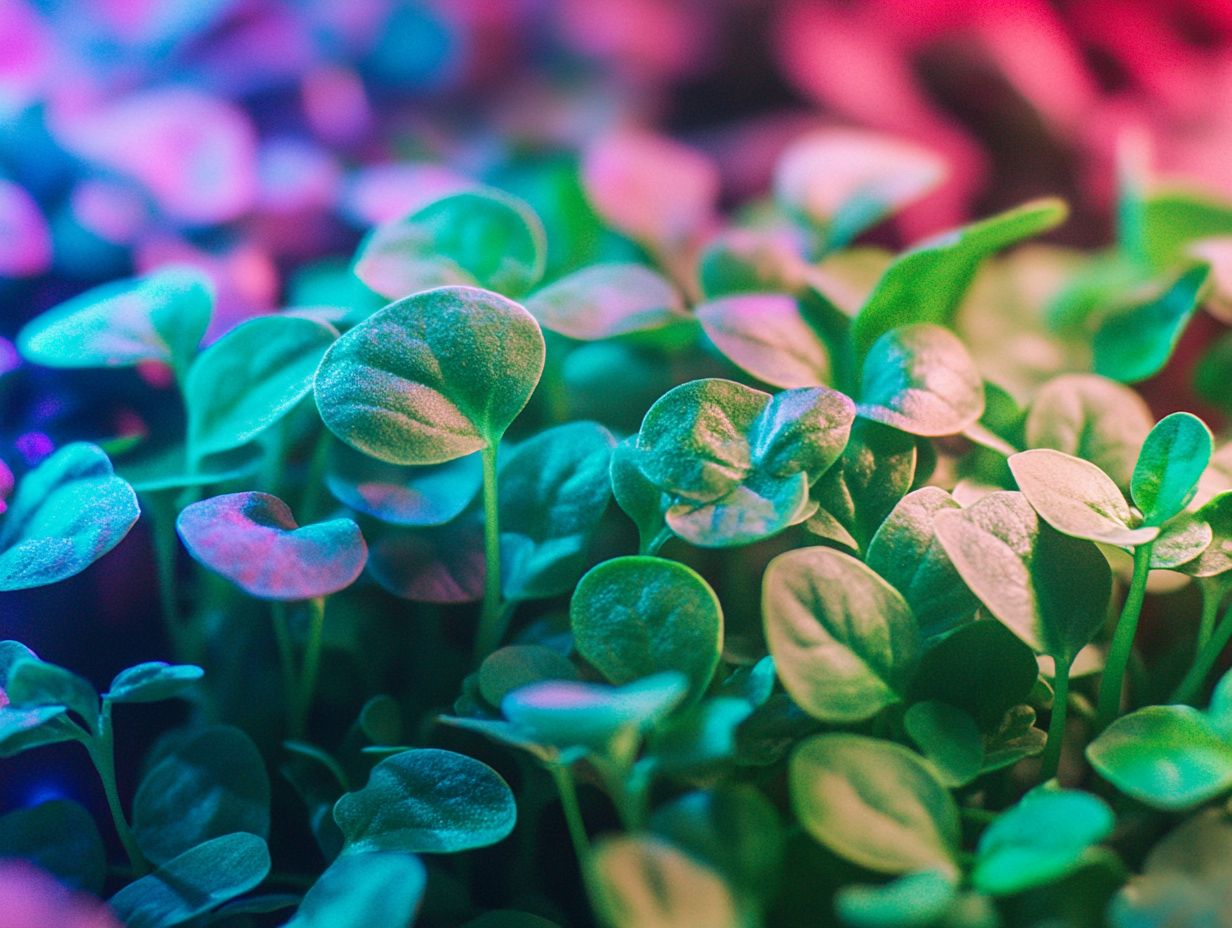
When selecting the right light spectrum for your microgreens, it s essential to consider factors influencing everything from energy consumption to growth rates.
Humidity and airflow are key factors in how well your microgreens grow. Temperature also requires your attention; keeping it in check is crucial to prevent stress and to foster optimal germination and development. Additionally, understanding the role of light in microgreen growth is vital for achieving the best results.
Each variety has its own unique growth requirements. For instance, rapid growers like radish need specific nutrient levels and moisture content to thrive. Achieving the perfect balance involves regular monitoring and adjustments, ensuring that each variety receives the ideal environment for a bountiful and flavorful harvest.
Tips for Using Light Spectrum to Maximize Growth
By employing targeted strategies for harnessing the light spectrum, you can markedly elevate the growth of your microgreens. This ensures they thrive with robust health and deliver a bountiful yield from your gardening endeavors!
Start by choosing the right light spectrum today. Your microgreens will thank you with a bountiful yield!
Lighting Set-Up and Placement
Proper lighting setup and placement are essential for successfully growing microgreens. They ensure that your plants receive the optimal light exposure needed for maximum growth.
The ideal distance for LED lights from your microgreens typically ranges from 12 to 24 inches, depending on the type of light you’re using and the growth stage of your plants. In the initial stages, keeping the lights closer helps foster stronger, healthier stems. For more information on the importance of light quality for microgreens, it’s important to note that more mature plants can thrive with a bit more space.
To achieve even coverage, position the lights to avoid shadowing. This might mean using multiple light sources or adjusting their angles. As your microgreens grow, adjust the height and duration of light exposure. For a deeper understanding of how to optimize this process, explore the science behind microgreen growth. This promotes consistent photosynthesis and vibrant colors throughout their life cycle.
Adjusting Light Spectrum for Different Stages of Microgreens Growth
Adjusting the light spectrum to match the various stages of microgreen growth can profoundly impact their development and overall quality, including factors like nutrient content and flavor.
For instance, seedlings flourish under cooler light temperatures rich in the blue spectrum. This is essential for maximizing light energy, promoting healthy leaf development and curbing that pesky legginess. As these plants mature, they thrive with a shift toward warmer light featuring more red wavelengths, spurring robust growth and vibrant coloring. To learn more about effective lighting, check out this guide on how to use grow lights for microgreens.
To facilitate this transition seamlessly, think about using programmable LED lights for your home! They can replicate the natural progression of sunlight throughout the day. For a deeper understanding, consider the role of light duration for microgreens. Maintaining the right distance between the light source and the plants enhances growth, striking the perfect balance of light intensity and wattage tailored to each growth stage.
Don t wait! Discover diverse options for LED lighting on Facebook and Amazon today.
Frequently Asked Questions
What is the importance of finding the right light spectrum for microgreens?
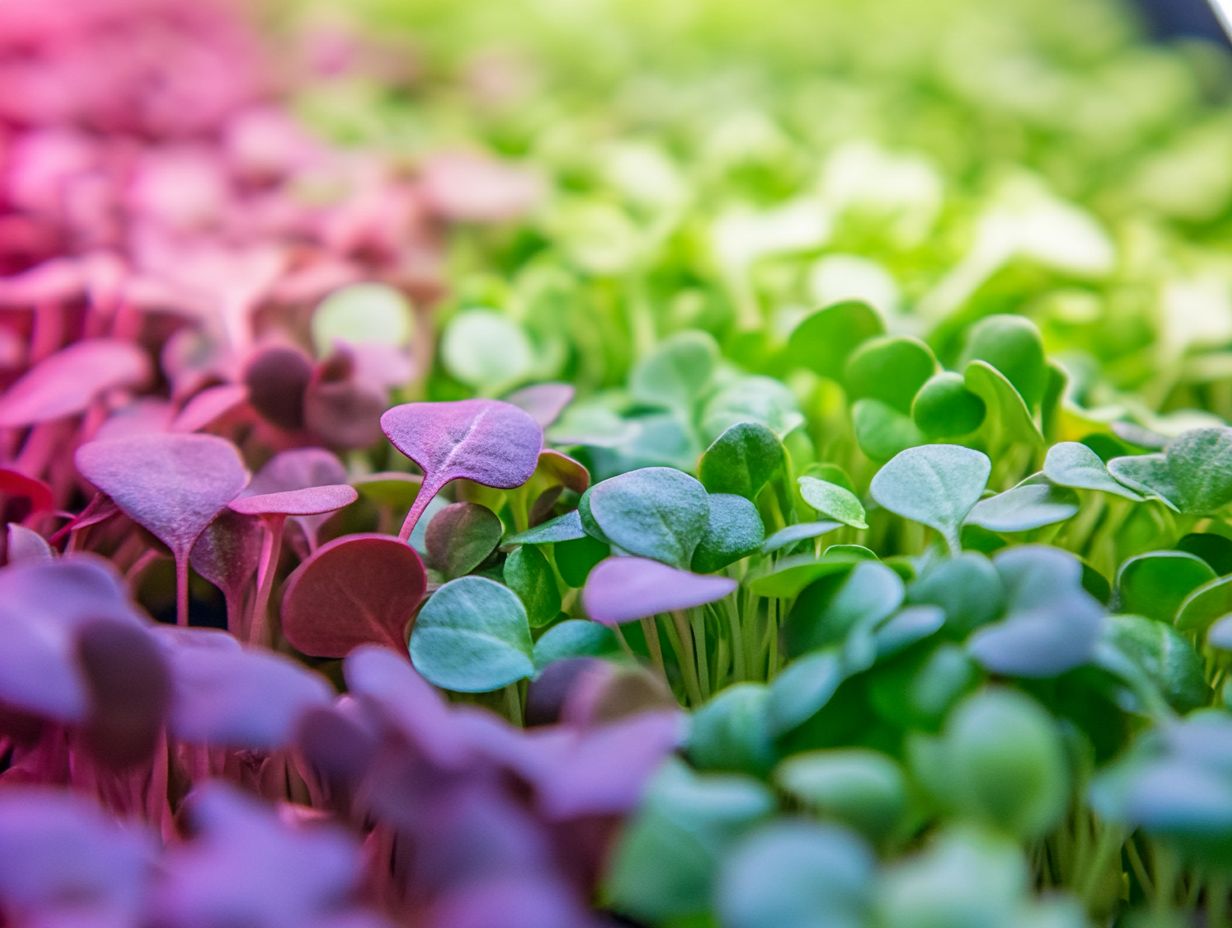
Finding the right light spectrum, including understanding energy consumption and LED wattage, is crucial for the growth and development of microgreens. The spectrum of light affects the color, taste, and nutritional value of the microgreens.
What are the different light spectrums that can be used for growing microgreens?
The three main light spectrums for growing microgreens are blue, red, and full spectrum. Many different types are available at retailers like Home Depot and Amazon. Each spectrum has a specific effect on the growth and development of microgreens.
Which light spectrum is best for promoting leafy growth in microgreens?
The blue light spectrum, often emitted by LED bulbs, is known to promote leafy growth in microgreens. This spectrum is ideal for growing microgreens with large, vibrant leaves.
Does the light spectrum affect the flavor of microgreens?
Yes, the light spectrum plays a role in the flavor and quality of microgreens. For example, microgreens grown under red light at 3000K tend to have a sweeter taste compared to those grown under blue light.
Can the light spectrum be adjusted during different stages of microgreen growth?
Yes, the light spectrum can be adjusted during different stages of microgreen growth. For example, blue light is ideal during the vegetative stage, while red light is beneficial during the flowering and fruiting stages. This allows plants to reach their full potential in a home microgreens setup.
What is the best way to determine the right light spectrum for my microgreens?
The best way to determine the right light spectrum for your microgreens is to experiment and observe the results. You can also consult with experienced growers or refer to podcasts and reliable reference materials for guidance.

